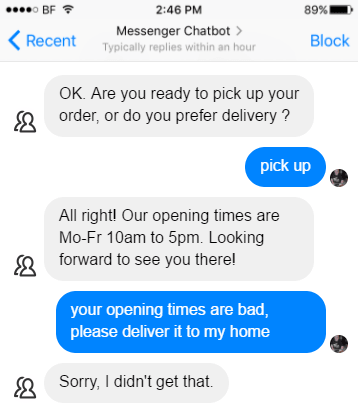For well over a year now, chatbots have been sold to us as the ultimate revolution in digital marketing. The wholesale replacement of mobile apps is en route! The holy grail of marketing 2.0 is turning the corner!
Really? I’ve got to call bullshit on this.
The hype around AI-enabled chatbots is attracting a lot of marketing professionals who can smell the money. It’s a whole new direction after side trips into social media marketing or growth hacking.
Well, new year, same bullshit. It has to be said that chatbots, though they are selling like hot cakes today, are mostly stupid and disappointing.
Years ago, it was social networks for brands, then came big data and programmatic advertising. The promise then —as now — was gaining easier, cheaper, access to infinite targeting possibilities and better ad delivery. But from a user perspective, things barely changed —uninteresting ads continued to relentlessly beat us over the head.
The A.I. hype machine
The ability to aggregate terabytes of data on millions of people is great. Doing something useful with that data is even better. Luckily, experts and consultants the world over have found a new messiah: Artificial Intelligence. (Let’s not forget to capitalize this all-important term, like they do in the press releases.)
One small problem. For many of these “experts,” artificial intelligence is a term as obscure as it is nebulous. A well known digital marketing consultant didn’t skip a beat when he told me a while back that “if it’s a rules engine, then it’s already artificial intelligence.” Er, no. That’s just basic coding and algorithm writing. Maybe it’s well-crafted, but that doesn’t make it artificial intelligence.
From artificial intelligence to intelligent artifice
Writing code that seems intelligent is not the same as getting a machine to learn all by itself. You set rules and program the machine to do certain things when it comes across identified conditions. This is what you find in 90 percent of what is sold today as AI.
A lot of companies are light years away from employing the machine learning or deep learning techniques they are selling. I’m not saying their solutions are ineffective, I’m just pointing out that overselling AI just to ride the bandwagon clearly amounts to false advertising — for clients as well as investors. Beware of the bubble.
It’s not surprising that users feel disappointed. So many bots fail at even the most basic tasks, bleating out “I don’t understand” when a user answers “yes” or “no” to what seems like a basic yes-or-no question. You see a lot of crap that is closer to the automated menus you reach when you call customer service than it is to futuristic AI.
Bot-building software is to blame for a lot of this lost credibility. Sure, it’s handy to be able to “code” chatbots using free drag-and-drop interfaces, but these quickly run into limitations when it comes to language recognition. It’s frustrating enough for the basic “yes/no” queries, so imagine what it’s like when you try and work on the finer points of intention detection. Bummer.
I’ve been trying out a lot of bots that are sold as artificial intelligence and posting some of the more giggle-worthy results on Twitter and LinkedIn. Try it yourself — you will quickly have serious questions about the utility of these tools. Really, some of these companies need to focus at least as much on testing their products as they do drafting press releases.

It’s really all about the user experience
Why bother with design and user experience when you could throw together something passable (in appearance) with free “development” tools? Well, yes, why?
Why not try and make something passable based on the simple recognition of user responses and at least pretend that the bot is minimally intelligent?
It is possible to design a chatbot that performs a real service, understands who the user is, and truly helps solve a well-defined problem. But it takes time and effort — iterating and testing with real people who would actually use the solution, without age or profession bias. You have to pass from theory to practice and get your hands dirty.
So where does artificial intelligence come in?
AI allows you to refine the natural-language recognition model and make conversations more fluid — to go beyond the detection of keywords. Today the most advanced players in the market — those who really use models trained on lots of real conversation data — are going a little further.
They are able to go beyond keyword detection (something certain chatbot startups that sell themselves as AI don’t even do) and get into intention detection.
A user can employ a number of different wordings or sentence structures to express the same intention. A trained machine is able to refine its responses while detecting intentions and find the corresponding answer within the corpus of data it holds. It can also detect semantic similarities to find the real correct response.
Trained machines also can detect aggressive or angry users and pass them onto a human operator who can pick up the conversation.
You have to know how to get the most of the different technologies available to you and combine a well-designed interface with an artificial motor that improves the experience beyond something that could be coded by hand.
Yes, you can use some basic AI in a chatbot project, given the right means. Or you could try selling stupid chatbots as AI. But that doesn’t involve intelligence — it’s a dark art.
A version of this article originally appeared on FrenchWeb.fr. Translation by James Connell.
Get the TNW newsletter
Get the most important tech news in your inbox each week.





